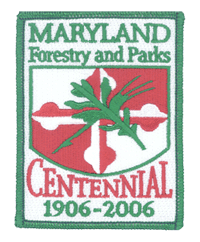 Fred W. Besley: Forestry Pioneer
Fred W. Besley: Forestry Pioneer
Maryland’s First State Forester
1906-1942
Part 1 of a 3-part series
Address by Francis “Champ” Zumbrun for the Maryland Forests Association Conference
Can you imagine Maryland without a state forest or
state park? Well, a little less than one hundred years ago, in 1905, there was
such a time. That all changed in 1906, when two brothers, John and Robert
Garrett, made a generous donation of 1,917 acres of forest land in Garrett
County to the State of Maryland. This tract of land is known today as Garrett
State Forest, Maryland’s first state forest. This donation, along with the
passing of the 1906 Forestry Conservation Act, marks the beginning of the
forestry conservation movement in Maryland (note: the legislature passed
the law on March 31, 1906 and Governor Edwin Warfield signed it on April 5,
1906).
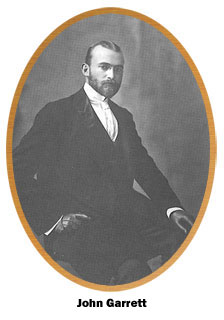 Just consider one accomplishment of many resulting
from the Garrett Brother’s initial benevolence: There were zero acres of state
public land in Maryland before their donation in 1906; today, as we celebrate
the Centennial of the Maryland Forest Service and the Maryland State Park
Service, there is a little less than 500,000 acres of state public land, making
up about 10% of Maryland’s land base. At the same time the forest land base
throughout the state increased from a little less than 30% 100 years ago to 41%
today.
Just consider one accomplishment of many resulting
from the Garrett Brother’s initial benevolence: There were zero acres of state
public land in Maryland before their donation in 1906; today, as we celebrate
the Centennial of the Maryland Forest Service and the Maryland State Park
Service, there is a little less than 500,000 acres of state public land, making
up about 10% of Maryland’s land base. At the same time the forest land base
throughout the state increased from a little less than 30% 100 years ago to 41%
today.
That’s incredible, especially when you recognize that
during the same time the population of Maryland tripled in size in 100 years,
from about 1.8 million in 1906 to about 5.6 million people in 2006. The Forest
conservation leaders of the past proved that it is possible to have economic
growth while at the same time improving the forest resource base and quality of
life issues. Somehow, they figured out that delicate balance.
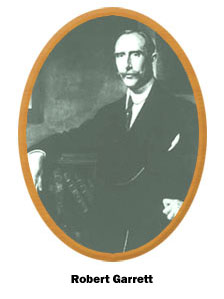 With the donation of forestland, the Garrett brothers
imposed several conditions that were soon legislated into the law in the 1906
Forestry Conservation Act. The State of Maryland was to make “adequate condition
for its [forests] care.” Maryland was required to establish a “State Board of
Forestry” for the purpose of overseeing management of this land. The law stated
that any additional gifts of land should be administered “as State Forest
Reserves…to be used …to demonstrate the practical utility of timber culture and
as a breeding place for game.”
With the donation of forestland, the Garrett brothers
imposed several conditions that were soon legislated into the law in the 1906
Forestry Conservation Act. The State of Maryland was to make “adequate condition
for its [forests] care.” Maryland was required to establish a “State Board of
Forestry” for the purpose of overseeing management of this land. The law stated
that any additional gifts of land should be administered “as State Forest
Reserves…to be used …to demonstrate the practical utility of timber culture and
as a breeding place for game.”
The 1906 Forestry Conservation Act addressed a variety
of additional environmental concerns of that time: over-cutting of timber,
livestock grazing in woodlots, and wildfires. All of the above activities had a
negative impact on forest regeneration.
The Law also provided guidelines for purchasing
additional public lands. For example, the State could spend no more than five
dollars per acre when purchasing additional public lands.
The 1906 Forestry Conservation Act mentions “parks”
along with “forest reserves”- the two coincide right from the very beginning.
That fact that no state parks existed in 1906 show that this document was indeed
progressive, forward-looking, and optimistic. In 1912, Patapsco Forest Reserve
near Baltimore became the first state park in Maryland.
The Law stated that the State Board of Forestry was
charged with appointing the State Forester. This person was not to be paid more
than $2,000 annually. More importantly, the State Forester was required to
“have practical knowledge of forestry.” The person holding this position would
not be just another political appointee, but would be required to have
professional forest management expertise.
The law in essence declared war on the
Age of Forest
Exploitation. The law made it clear that the science of forestry would be the
tool to heal Maryland’s devastated landscape. The 1906 Forestry Conservation Act
was so progressive and pioneering, that it quickly put Maryland in the forefront
of the national forestry conservation movement at the State level. The law
called for State Forester to be in charge of carrying out its mandates in
Maryland.
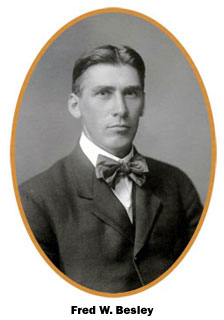 Besley’s arrival in 1906 as Maryland’s first State
Forester marks the beginning of a new forestry conservation era called the
“Custodial” period, lasting generally between the years 1906-1942. During this
time, management placed its emphasis on protecting, nurturing, and restoring the
forest back to health. Foresters surveyed and mapped the forests for the first
time. Foresters established tree nurseries in Maryland to aid in ecological
restoration and acquired land for state public use. The custodial period
coincided with the entire span of Fred W. Besley’s career as State Forester.
During this time Besley described his mission as reversing "destructive
agencies, which for 150 years have been operating in the forests. Chief among
them are forests fires, destructive cutting practices, excessive grazing, and
the ravages of insects and fungus diseases."
Besley’s arrival in 1906 as Maryland’s first State
Forester marks the beginning of a new forestry conservation era called the
“Custodial” period, lasting generally between the years 1906-1942. During this
time, management placed its emphasis on protecting, nurturing, and restoring the
forest back to health. Foresters surveyed and mapped the forests for the first
time. Foresters established tree nurseries in Maryland to aid in ecological
restoration and acquired land for state public use. The custodial period
coincided with the entire span of Fred W. Besley’s career as State Forester.
During this time Besley described his mission as reversing "destructive
agencies, which for 150 years have been operating in the forests. Chief among
them are forests fires, destructive cutting practices, excessive grazing, and
the ravages of insects and fungus diseases."
Gifford Pinchot, the Founding Father of forestry in
America and advisor to President Theodore Roosevelt, personally handpicked and
oversaw Fred Besley’s career with the U.S. Forest Service. Pinchot also had a
hand and influence in selecting Besley as Maryland’s first State Forester.
Besley wrote about this in his unpublished
autobiography. Besley mentions giving a talk at the Annual meeting of the
Colorado Forestry Association in Denver where he was the principal speaker.
Besley writes, “I did not know until after the meeting that Gifford Pinchot, the
Chief Forester, was in the audience. He had come in unexpectedly. I had a short
talk with him at the close of the program and suspect this chance meeting with
him had something to do with my selection for the Maryland job, although it was
not even intimated then.”
Besley mentioned that while he was working at Pike’s
Peak National Forest he received an offer for the newly created Maryland State
Forester position. Besley wrote: “The offer came in a telegram from Gifford
Pinchot and was delivered on horseback at out our remote camp 10 miles from the
nearest telegraph station and difficult to locate, - adding to our surprise. The
offer came from Mr. Pinchot, Chief Forester, who had been asked to recommend a
qualified man and who was guaranteeing a part of the salary. It appears I was
selected because I had taken academic work at the Maryland State College and
because of my good record at the Yale Forest School and later field work in
Nebraska and Colorado known to Mr. Pinchot.”
Besley first was a teacher before he was a forester.
He taught in a one-room schoolhouse for eight years in Virginia (1892 -1900).
Than Besley worked for six years with The U.S. Forest Service as a “student
assistant” under Gifford Pinchot (1900-1906). During this time, Besley attended
Yale Forestry School and graduated with honors (1904). Indeed, in 1906, it would
have been hard to find someone more qualified than Fred Besley to be State
Forester. Besley’s first day at work as a State Forester began on June 20,
1906. His starting salary was $1,500, of which $300 was paid by the U.S. Forest
Service.
In his role as a State Forester, Besley set a very
high standard for those who followed after him, raising the bar high, pioneering
and establishing many scientific forestry practices in Maryland. He was a
trailblazing, forestry pioneer. His life was one that truly inspires. When one
looks at Fred W. Besley’s career, one looks at the very beginnings and
advancement of forest conservation in Maryland, for they both coincide.
|
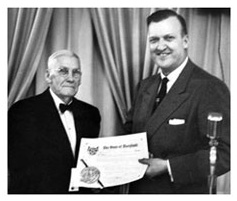 In 1956, the year of Maryland Forest Service’s 50th
anniversary, Governor McKeldin presented a signed certificate to Besley. The
certificate noted how Besley “pioneered the magnificent tasks of conservation
and reforestation ” and how Maryland forestry practices “became the models for
other States and Commonwealths of the Nation;” and noted how Besley was
“recognized as the spearhead and inspiration for the great accomplishments of
the years…from 1906 to 1942.”
In 1956, the year of Maryland Forest Service’s 50th
anniversary, Governor McKeldin presented a signed certificate to Besley. The
certificate noted how Besley “pioneered the magnificent tasks of conservation
and reforestation ” and how Maryland forestry practices “became the models for
other States and Commonwealths of the Nation;” and noted how Besley was
“recognized as the spearhead and inspiration for the great accomplishments of
the years…from 1906 to 1942.”
Remarkably, Robert Garrett, who back in 1906 donated
the first lands to become state forest, was present too at this anniversary
celebration. This must have been quite an event! Governor McKeldin told Besley,
then 84 years old, that there was still much work for him to do and accomplish,
reminding him that Noah was 300 years old before he started building the ark.
|
The idea for the theme of this paper, “Fred Besley:
Forestry Pioneer,” came from the first conservation I had over the telephone
with Helen Besley Overington, the daughter of Fred W. Besley. Helen told me,
“Being one of the first state foresters, Father had to pioneer everything.” In
fact, Besley was the third State Forester in the Country. Pennsylvania was the
first to have a State Forester, in 1896; Wisconsin the second, in 1904; and
Maryland the third, in 1906. Fred Besley wrote in his unpublished autobiography:
"Maryland was one of the first states to select a technically trained forester to
head up and direct all forest work. I [t] was real pioneering in Maryland, with
no precedents or guides to follow.”
When you think of a “pioneer” you also think of a
“frontier.” One hundred years ago, forestry was the frontier of science. Besley
was Maryland’s original trailblazer, bringing the science of forestry to
Maryland.
When Besley began his career as State Forester, the
condition of Maryland’s woodlands, in Besley’s words, were “devastated.” The
seemingly “inexhaustible” timber resources were exhausted, consisting of cutover
landscapes, and seedling/sapling sized forests. There was concern spreading
around the country that America was running out of timber.
Besley called this period, the “Age of Forest
Exploitation.” Timber volume greatly exceeded growth. Only 20% forest cover
remained east of the Mississippi River (Note: Maryland fared just a little bit
better with less than 30% of it’s original 95% forest cover remaining).
In the country, timber removal peaked in 1909 at 44 ½
billion board feet. Besley later used this benchmark number of 44 ½ billion
board feet for a warning and red flag when annual harvests during World War II
again began to approach 1909 peak harvesting levels.
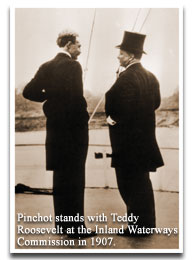 Besley held traits in common with other contemporary
conservation leaders like Gifford Pinchot and Theodore Roosevelt - they were
sportsmen; they were avid hunters who shared a passion for wildlife, forests,
and wilderness. Besley especially enjoyed hunting waterfowl. Sportsmen like
him, interacting closely with the land, would be among the first to notice any
environmental problems.
Besley held traits in common with other contemporary
conservation leaders like Gifford Pinchot and Theodore Roosevelt - they were
sportsmen; they were avid hunters who shared a passion for wildlife, forests,
and wilderness. Besley especially enjoyed hunting waterfowl. Sportsmen like
him, interacting closely with the land, would be among the first to notice any
environmental problems.
In 1906, it would have been hard to find someone more
qualified than Fred. W. Besley for the position of State Forester. He had quite
an impressive resume.
Besley was a teacher first before he was a forester.
In 1892, he graduated from the Maryland Department of Agriculture at the
University of Maryland. Between 1892-1900, for eight years, he taught at a
one-room schoolhouse in Fairfax County, Virginia.
In 1898, Besley met Gifford Pinchot at the U.S.
Department of Agriculture in Washington, D.C. Besley met Pinchot through a
member of the Sherman family. The Shermans were neighbors of the Besleys in
Vienna, Virginia. Pinchot was only a couple of years older than Besley and they
took to each other immediately.
The meeting changed Besley’s life. Pinchot told Besley
he ought to go in forestry. Besley later recalled this defining moment of the
time they first met: “Pinchot was so boiling over with enthusiasm about forestry
that then and there I adopted forestry as my career.” Besley now wanted to be a
forester!
However, it wouldn’t be until two years after their
first meeting, in 1900, that Pinchot secured enough federal funds to hire
“student assistants” to work for him. Besley was one of 61 applicants chosen
from 232 applications received.
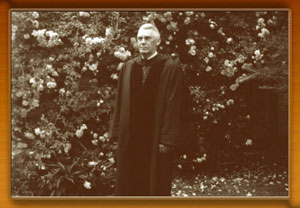 Besley could put on his resume that he was personally
hand-picked by Gifford Pinchot for federal employment as a forester; that he was
one of Pinchot’s first field foresters; and, that he trained and worked under
Pinchot’s direction for six years, between 1900-1906 with the U.S. Forest
Service in nine different states.
Besley could put on his resume that he was personally
hand-picked by Gifford Pinchot for federal employment as a forester; that he was
one of Pinchot’s first field foresters; and, that he trained and worked under
Pinchot’s direction for six years, between 1900-1906 with the U.S. Forest
Service in nine different states.
Under Pinchot, Besley learned all aspects of forest
resource management, both as a field forester, and academically as a student at
the Yale School of Forestry, where in 1904 he graduated with honors. At this
time, Besley was 32 years old, married, and the father of two children. During
this time with the U. S. Forest Service, Besley supported himself and his family
earning $25 per month as a field forester, and in the winter, $40 per month
transforming the collected field data into statistical forestry reports.
Between 1901-1902, during winter months on Thursday
nights, Pinchot invited his student assistants to his home in Washington D.C. to
listen to inspiring talks about forest conservation from various leaders in the
field. These meetings became known as the “Baked Apple Club,” for after a
speaker finished their presentation, Mrs. Pinchot promptly served the students
baked apples and gingerbread.
Can you imagine a President of the United States, one
that is enthusiastic about forest conservation, attending one of your forestry
meetings? Fred Besley had that experience! Helen Besley Overington told me:
“They could have all the gingerbread and baked apples they wanted. One night
Pinchot told them they were going to have a special guest…that special guest was
President Theodore Roosevelt!”
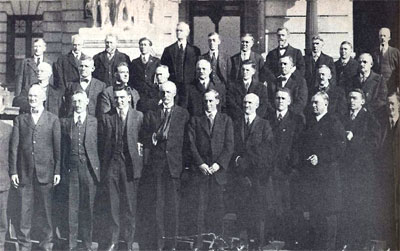 |
|
The only known photograph
with both Gifford Pinchot and Fred W. Besley seen together was taken
in 1920 at the First State Forester's Association Conference in
Harrisburg, Pa. Pinchot is 4th from the left in the front row.
Besley is third from the right in the top row. |
There is only one known photograph with both Pinchot
and Besley seen together, taken in 1920 at the First State Forester’s Association
conference at Harrisburg, Pennsylvania. In this photograph Besley is 48 years
old and stands with a group of state foresters from around the country. At this
time, Besley was the senior state forester; he put Maryland at the forefront of
the conservation movement. The other men looked up to Besley for guidance. The
State Forester’s Association nominated and selected Besley for chair of the
organization about three years after this photograph.
Many important individuals worked together during the
early conservation movement. These men and women worked closely with Besley
throughout his career, giving him much support and contributing greatly to his
success. Because of space limitations, I’ll just mention a few of them: As
mentioned before, there were John and Robert Garrett who in 1906, made a
generous gift of 1, 917 acres of forest land to the State of Maryland. This
tract of land is part of Garrett State Forest, Maryland’s first state forest.
This donation of land, along with the passing of the 1906 Forestry Conservation
Act into law, marks the beginning of the Forestry Conservation movement in
Maryland.
The following associates of Besley’s were involved in
the political world and can be considered the legislative champions for the 1906
Forestry Conservation Act:
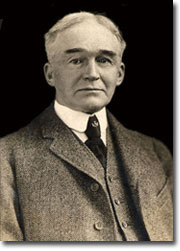 |
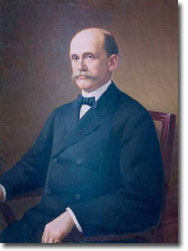 |
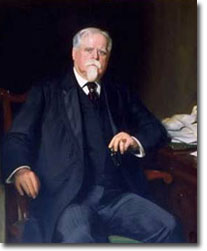 |
State Senator
1906-1910
W. McCulloh Brown |
President, State Senate
1906-1910
Colonel Joseph Seth |
Governor of Maryland
1904-1908
Edwin Warfield
|
-
Senator W. McCulloh Brown of Garrett County
(1906-1910) wrote, introduced, and secured the first forestry bill for Maryland.
Some historians believe Brown had a little help drafting law from fellow Yale
alumni member, Gifford Pinchot.
-
Colonel Joseph Seth, President of the State
Senate (1906-1910) moved the forestry legislation through legislature for
approval; and,
-
Governor Edwin Warfield (1904-1908) signed the legislation into
law on April 5, 1906, the official date for the beginning of the Maryland State
Forestry Board.
Another important associate of Besley’s was William
Bullock Clark (1860-1917). Clark was the Department Head of the Maryland
Geological Survey at Johns Hopkins University. In 1906, Clark was one of
Maryland’s best known and respected scientists. As the first executive officer
of the Maryland Board of Forestry, Clark was Besley’s first boss as a State
Forester. Although not a forester, Clark had a profound concern for the poor
condition of Maryland’s forests that he observed traveling around the state
while conducting geological fieldwork. As a note of interest, W. Bullock Clark
was one of three officials whom Governor Warfield sent to attend President
Theodore Roosevelt’s 1908 White House Conservation Conference. I wonder what
stories he told Besley about the conference.
Bullock Clark oversaw Maryland’s first official forest
survey. This survey occurred in Allegany County in the year 1900, six years
before the Board of Forestry was created in 1906. George. B. Sudworth, a
forester for the U.S. Forest Service, conducted the fieldwork under Bullock
Clark’s direction.
I have found an old
photograph taken in 1901 (above on the right) of George B. Sudworth conducting fieldwork in the
western part of the U.S. Sudworth sits on a mule dressed like a cowboy with hat,
holster and pistols, with a rifle mounted on the saddle. Indeed back then,
foresters were much like cowboys. Pinchot required that his foresters know how
to ride a horse/ and or mule, camp and take care of themselves for long periods
of time in the great outdoors.
However, there was one big
difference between cowboys and foresters back then: cowboys pushed cattle on the
open plains, their primary interest…to get cattle to market; foresters pushed
cattle out of the woodlands onto the open plains, their primary interest… to
protect forest regeneration and restore the forest landscape.
Besley left behind a rich legacy of documentation in
written form and photographic images, many preserved as lanternslides. They are
archived at the Hall of Records in Annapolis, Maryland.
Acknowledgements:
Address by Francis “Champ”
Zumbrun for the Maryland Forests Association Conference Centennial Kick-off,
November 5, 2005. Francis "Champ" Zumbrun is the forest manager at Green Ridge State Forest. He has
worked as a professional forester for DNR since 1978. He serves on the Forestry
and Parks Centennial Committee.
The author would especially like to thank Ross Kimmel, Robb Bailey, Offutt Johnson, Helen Besley Overington, Kirk Rodgers, Mary Rotz, Don and Peggy Weller, and Rob Schoeberlein of the Maryland State Archives, and Silas Sines, Jr. for graciously providing historical documents and
photographs that greatly helped in the preparation of this article.
Photographs (top to
bottom):
-
John Work Garrett, 1899
-
Robert Garrett
-
Fred W. Besley
-
Maryland Forest Service’s 50th Anniversary
Governor McKeldin presenting a signed certificate to Fred W. Besley, 1956
-
Gifford Pinchot (left) stands with Teddy Roosevelt at the
Inland Waterways Commission in 1907
-
Fred W. Besley, graduation from Yale School of Forestry,
1904
-
First State Forester's Association Conference in
Harrisburg, Pa., 1920
-
State Senator 1906-1910,
W. McCulloh Brown
-
President, State Senate, 1906-1910,
Colonel Joseph Seth
-
Governor of Maryland, 1904-1908,
Edwin Warfield
-
William Bullock Clark,
Maryland State Geologist, 1896-1917
-
George. B. Sudworth (right), a
forester for the U.S. Forest Service